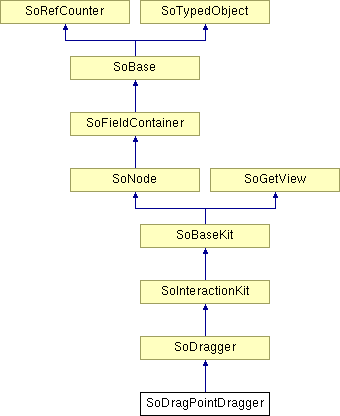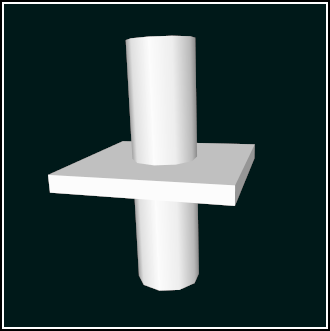SoDragPointDragger Class Reference
[Draggers]
Object you can translate in 3D by dragging with the mouse. More...
#include <Inventor/draggers/SoDragPointDragger.h>

Public Types | |
| enum | DraggerSet { X_AXIS, Y_AXIS, Z_AXIS } |
Public Member Functions | |
| virtual SoType | getTypeId () const |
| virtual const SoNodekitCatalog * | getNodekitCatalog () const |
| SoDragPointDragger () | |
| void | setJumpLimit (float limit) |
| float | getJumpLimit () const |
| void | showNextDraggerSet () |
| void | showDraggerSet (DraggerSet set) |
Static Public Member Functions | |
| static SoType | getClassTypeId () |
| static const SoNodekitCatalog * | getClassNodekitCatalog () |
Public Attributes | |
| SoSFVec3f | translation |
Detailed Description
Object you can translate in 3D by dragging with the mouse.
SoDragPointDragger is a compound dragger that translates in all three dimensions when dragged with the mouse.
It is made up of six smaller draggers, which it displays two at a time. Each pair has one plane dragger and one line dragger. The line dragger is oriented perpendicular to the plane, so together the plane/line pair lets you move through all of 3-space.
DragPoint has a total of three such pairs, oriented along the x, y, and z axes of its local space. You can cycle through the three pairs by hitting the <Control> key with the cursor over the dragger. (You need not press the mouse button.) This behavior may be disabled by setting the environment variable OIV_DISABLE_DRAGGER_CTRL_KEY to true (see SoPreferences). An application can cycle through the pairs by calling the showNextDraggerSet method or display a specific pair by calling the showDraggerSet method. The dragger starts with the Y axis (y-line/xz-plane) pair displayed.
The line draggers are SoTranslate1Draggers and the plane draggers are SoTranslate2Draggers. So you can use the <Shift> key to constrain the motion of a plane dragger along one of the two axes within the plane, as described in the SoTranslate2Draggers reference page.
DragPoint adds extra feedback parts to provide a more intuitive idea of where you are placed in three-space. There are three feedback planes and three feedback axes ; each corresponds to one of the plane or line draggers, but spans a much greater distance. When you drag along a line, that line's larger feedback axis is displayed, and remains anchored in space while the dragger slides along it. This helps establish the motion of the dragger relative to the rest of the scene. Similarly, when you drag within a plane, the larger (but transparent) feedback plane establishes a ground plane for you to move upon. The location of the dragger within the plane is pinpointed by two intersecting axes that always cross below the cursor and extend to the edges of the plane. When you move dragPoint to the edge of the feedback plane (or line), the feedback will jump to a new location in that direction, so that the dragger never leaves the feedback behind.
The primary directions of motion are given by the local space of the dragger. Transforms earlier in the scene will affect the dragger, its children, and the orientation of its directions of motion.
This node has a translation field which always reflects its position in local space. Setting the field moves the dragger to that point. You can also connect fields of other nodes or engines from this one to make them follow the dragger's motion.
Although the child draggers each have their own resources defining default part geometries, the dragPoint dragger overrides these with a new set of resources. It also defines resources for the feedback parts that it adds. These are detailed in the Dragger Resources section of the online reference page for this class. You can change the parts in any instance of this dragger using setPart().
You can make your program use different default resources for the parts by copying the file $OIVHOME/data/draggerDefaults/dragPointDragger.iv into your own directory, editing the file, and then setting the environment variable SO_DRAGGER_DIR to be a path to that directory.
See SoDragger for more information about using and customizing draggers, including code examples, using draggers in an immersive VR environment and using WYSIWYG draggers.

FILE FORMAT/DEFAULT
- DragPointDragger {
| renderCaching | AUTO |
| boundingBoxCaching | AUTO |
| renderCulling | AUTO |
| pickCulling | AUTO |
| isActive | FALSE |
| translation | 0 0 0 |
| callbackList | NULL |
| xTranslator | Translate1Dragger { |
| } | |
| xyTranslator | Translate2Dragger { |
| } | |
| xzTranslator | Translate2Dragger { |
| } | |
| zTranslator | Translate1Dragger { |
| } | |
| yzTranslator | Translate2Dragger { |
| } | |
| yTranslator | Translate1Dragger { |
| } | |
| xFeedback | <dragPointXFeedback resource> |
| yFeedback | <dragPointYFeedback resource> |
| zFeedback | <dragPointZFeedback resource> |
| yzFeedback | <dragPointYZFeedback resource> |
| xzFeedback | <dragPointXZFeedback resource> |
| xyFeedback | <dragPointXYFeedback resource> |
| xTranslator.translator | <dragPointXTranslatorTranslator resource> |
| xTranslator.translatorActive | <dragPointXTranslatorTranslatorActive resource> |
| yTranslator.translator | <dragPointYTranslatorTranslator resource> |
| yTranslator.translatorActive | <dragPointYTranslatorTranslatorActive resource> |
| zTranslator.translator | <dragPointZTranslatorTranslator resource> |
| zTranslator.translatorActive | <dragPointZTranslatorTranslatorActive resource> |
| yzTranslator.translator | <dragPointYZTranslatorTranslator resource> |
| yzTranslator.translatorActive | <dragPointYZTranslatorTranslatorActive resource> |
| xzTranslator.translator | <dragPointXZTranslatorTranslator resource> |
| xzTranslator.translatorActive | <dragPointXZTranslatorTranslatorActive resource> |
| xyTranslator.translator | <dragPointXYTranslatorTranslator resource> |
| xyTranslator.translatorActive | <dragPointXYTranslatorTranslatorActive resource> |
DRAGGER RESOURCES
| Resource: | dragPointXTranslatorTranslator |
| Part: | xTranslator.translator |
| Appearance: | white cylinder with axis aligned in X direction |
| Description: | picking this initiates linear motion in X direction |
| Resource: | dragPointXTranslatorTranslatorActive |
| Part: | xTranslator.translatorActive |
| Appearance: | yellow cylinder with axis aligned in X direction |
| Description: | shown when moving in X direction |
| Resource: | dragPointYTranslatorTranslator |
| Part: | yTranslator.translator |
| Appearance: | white cylinder with axis aligned in Y direction |
| Description: | picking this initiates linear motion in Y direction |
| Resource: | dragPointYTranslatorTranslatorActive |
| Part: | yTranslator.translatorActive |
| Appearance: | yellow cylinder with axis aligned in Y direction |
| Description: | shown when moving in Y direction |
| Resource: | dragPointZTranslatorTranslator |
| Part: | zTranslator.translator |
| Appearance: | white cylinder with axis aligned in Z direction |
| Description: | picking this initiates linear motion in Z direction |
| Resource: | dragPointZTranslatorTranslatorActive |
| Part: | zTranslator.translatorActive |
| Appearance: | yellow cylinder with axis aligned in Z direction |
| Description: | shown when moving in Z direction |
| Resource: | dragPointYZTranslatorTranslator |
| Part: | yzTranslator.translator |
| Appearance: | white flattened cube within the yz plane of motion |
| Description: | picking this initiates planar motion in yz plane |
| Resource: | dragPointYZTranslatorTranslatorActive |
| Part: | yzTranslator.translatorActive |
| Appearance: | yellow flattened cube within the yz plane of motion |
| Description: | shown when moving in yz plane |
| Resource: | dragPointXZTranslatorTranslator |
| Part: | xzTranslator.translator |
| Appearance: | white flattened cube within the xz plane of motion |
| Description: | picking this initiates planar motion in xz plane |
| Resource: | dragPointXZTranslatorTranslatorActive |
| Part: | xzTranslator.translatorActive |
| Appearance: | yellow flattened cube within the xz plane of motion |
| Description: | shown when moving in xz plane |
| Resource: | dragPointXYTranslatorTranslator |
| Part: | xyTranslator.translator |
| Appearance: | white flattened cube within the xy plane of motion |
| Description: | picking this initiates planar motion in xy plane |
| Resource: | dragPointXYTranslatorTranslatorActive |
| Part: | xyTranslator.translatorActive |
| Appearance: | yellow flattened cube within the xy plane of motion |
| Description: | shown when moving in xy plane |
| Resource: | dragPointXFeedback |
| Part: | xFeedback |
| Appearance: | douple-headed purple arrow |
| Description: | feedback for motion in x direction |
| Resource: | dragPointYFeedback |
| Part: | yFeedback |
| Appearance: | douple-headed purple arrow |
| Description: | feedback for motion in y direction |
| Resource: | dragPointZFeedback |
| Part: | zFeedback |
| Appearance: | douple-headed purple arrow |
| Description: | feedback for motion in z direction |
| Resource: | dragPointYZFeedback |
| Part: | yzFeedback |
| Appearance: | semi-transparent green square in yz plane |
| Description: | feedback for motion in yz plane |
| Resource: | dragPointXZFeedback |
| Part: | xzFeedback |
| Appearance: | semi-transparent green square in yz plane |
| Description: | feedback for motion in xz plane |
| Resource: | dragPointXYFeedback |
| Part: | xyFeedback |
| Appearance: | semi-transparent green square in yz plane |
| Description: | feedback for motion in xy plane |
CATALOG PARTS
- All Parts
| Part Name | Part Type | Default Type | NULL Default |
| callbackList | NodeKitListPart | -- | yes |
| xTranslator | Translate1Dragger | -- | yes |
| xyTranslator | Translate2Dragger | -- | yes |
| xzTranslator | Translate2Dragger | -- | yes |
| zTranslator | Translate1Dragger | -- | yes |
| yzTranslator | Translate2Dragger | -- | yes |
| yTranslator | Translate1Dragger | -- | yes |
| xFeedback | Separator | -- | yes |
| yFeedback | Separator | -- | yes |
| zFeedback | Separator | -- | yes |
| yzFeedback | Separator | -- | yes |
| xzFeedback | Separator | -- | yes |
| xyFeedback | Separator | -- | yes |
Extra Information for List Parts from Above Table
| Part Name | Container Type | Possible Types |
| callbackList | Separator | Callback, EventCallback |
SEE ALSO
SoInteractionKit, SoDragger, SoCenterballDragger, SoDragPointDragger, SoHandleBoxDragger, SoJackDragger, SoPointLightDragger, SoRotateCylindricalDragger, SoRotateDiscDragger, SoRotateSphericalDragger, SoScale1Dragger, SoScale2Dragger, SoScale2UniformDragger, SoScaleUniformDragger, SoSpotLightDragger, SoTabBoxDragger, SoTabPlaneDragger, SoTrackballDragger, SoTransformBoxDragger, SoTransformerDragger, SoTranslate1Dragger, SoTranslate2Dragger
Member Enumeration Documentation
Constructor & Destructor Documentation
| SoDragPointDragger::SoDragPointDragger | ( | ) |
Constructor.
Member Function Documentation
| static const SoNodekitCatalog* SoDragPointDragger::getClassNodekitCatalog | ( | ) | [static] |
Returns the SoNodekitCatalog for this class.
Reimplemented from SoDragger.
| static SoType SoDragPointDragger::getClassTypeId | ( | ) | [static] |
Returns the type identifier for this class.
Reimplemented from SoDragger.
| float SoDragPointDragger::getJumpLimit | ( | ) | const [inline] |
Gets the point at which the feedback axes will jump to a new position.
| virtual const SoNodekitCatalog* SoDragPointDragger::getNodekitCatalog | ( | ) | const [virtual] |
Returns the SoNodekitCatalog for this instance.
Reimplemented from SoDragger.
| virtual SoType SoDragPointDragger::getTypeId | ( | ) | const [virtual] |
Returns the type identifier for this specific instance.
Reimplemented from SoDragger.
| void SoDragPointDragger::setJumpLimit | ( | float | limit | ) | [inline] |
Sets the point at which the feedback axes will jump to a new position.
For example, if set to .1 (the default), the feedback axes will jump when the dragger gets within 10% of the end of the axis.
| void SoDragPointDragger::showDraggerSet | ( | DraggerSet | set | ) |
The dragPoint dragger contains three pairs of draggers, each containing a plane dragger and a line dragger (see the Description above).
By default the Y axis (y-line/xz-plane) pair is displayed. Calling this method selects a specific pair.
| void SoDragPointDragger::showNextDraggerSet | ( | ) |
The dragPoint dragger contains three pairs of draggers, each containing a plane dragger and a line dragger (see the Description above).
The dragger starts with the (y-line/xz-plane) pair displayed. Calling this method will cycle next through the (z-line/xy-plane), then the (x-line/yz-plane).
Member Data Documentation
Position of the dragger.
The documentation for this class was generated from the following file:
- Inventor/draggers/SoDragPointDragger.h